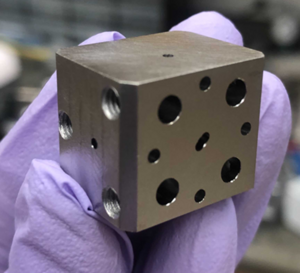Researchers have found a way to convert quantum information between different kinds of quantum technologies. Rubidium atoms have two gaps in their levels that can be exploited to shift the electron’s energy up and down using lasers. By doing so, the atom can absorb a microwave photon with quantum information and then emit an optical photon with that quantum information, a process called transduction. The technology uses a superconducting, reflective chamber in which a photon is trapped. The photon is forced to bounce around in the enclosed space, strengthening the interaction between the photon and whatever matter is placed inside it. The technology works both ways, transferring quantum information from microwave photons to optical photons and vice versa, making it possible to connect two superconducting qubit quantum computers on either side of a long-distance connection and serve as a fundamental building block to a quantum internet. This breakthrough could have significant implications for the development of a quantum internet and quantum computing, as it opens up the possibility of creating a quantum network.
Researchers have made a groundbreaking discovery in the field of quantum technology that could have significant implications for quantum computing, communication, and networking. They have found a way to “translate” quantum information between different kinds of quantum technologies, paving the way for the development of a quantum internet.
The research, published in the prestigious journal Nature, was funded by the Army Research Office, the Air Force Office of Scientific Research, and the NSF Quantum Leap Challenge Institute for Hybrid Quantum Architectures and Networks. The study is a new way to convert quantum information from the format used by quantum computers to the format needed for quantum communication.
Photons are essential for quantum information technologies, but different technologies use them at different frequencies. For example, some of the most common quantum computing technology is based on superconducting qubits, such as those used by Google and IBM. These qubits store quantum information in photons that move at microwave frequencies.
However, if you want to build a quantum network or connect quantum computers, you can’t use microwave photons because their grip on their quantum information is too weak to survive the trip. The solution is to transfer the quantum information to a higher-frequency photon called an optical photon, which is much more resilient against ambient noise. But the information can’t be transferred directly from photon to photon; instead, intermediary matter is required.
In the experiment, atoms were used as intermediary matter to transfer quantum information from the format used by quantum computers to the format needed for quantum communication. The experiment aimed to achieve something more fundamental than other experiments that used solid state devices for this purpose.
The discovery could have significant implications for the development of a quantum internet, which would be able to transmit information with unprecedented security and speed. This breakthrough could make it possible to build a quantum network and connect quantum computers that use different types of quantum technology.
A new technology that exploits the gaps in rubidium atoms’ energy levels has been developed by researchers. The electrons in atoms can only have certain specific amounts of energy, called energy levels. When an electron is excited to a higher energy level, it can be done by hitting it with a photon whose energy matches the difference between the higher and lower level. And when it drops to a lower energy level, the atom emits a photon with an energy that matches the energy difference between levels.
Rubidium atoms have two gaps in their levels that the technology exploits, one that matches the energy of a microwave photon and the other that matches the energy of an optical photon. By shifting the atom’s electron energies up and down using lasers, the atom can absorb a microwave photon with quantum information and then emit an optical photon with that quantum information. This conversion of quantum information between different modes is known as transduction.
Controlling atoms at the atomic scale has become possible due to significant advances in manipulating such small objects. Researchers can now control almost everything about the atoms, making the experiment controlled and efficient. The technology uses a superconducting, reflective chamber in which a photon is trapped. The photon is forced to bounce around in the enclosed space, strengthening the interaction between the photon and whatever matter is placed inside it.
The technology can transfer quantum information both ways, making it possible to connect two superconducting qubit quantum computers on either side of a long-distance connection and serve as a fundamental building block to a quantum internet. The technology’s ability to strongly entangle atoms and photons could have many applications, from computing to simulations to metrology and atomic clocks.
This new technology could be a significant breakthrough in quantum information and computing, as it opens up the possibility of creating a quantum internet, which could transmit information with unprecedented security and speed. The ability to transfer quantum information between different modes could have far-reaching implications for the development of a quantum network and connecting quantum computers that use different types of quantum technology.
The accuracy of news releases posted on EurekAlert! by contributing institutions is not the responsibility of AAAS and EurekAlert!, nor the use of any information through the EurekAlert system.
Don’t miss interesting posts on Famousbio
